Collecting Data Teaching Resources
Teach students methods of collecting data, collection tools and how to organise this mathematical information with worksheets, activities, Google Slide templates and more teacher-created resources for your maths class.
Aligned with Austrailian maths curriculum standards, the teacher resources in this collection were designed to save teachers time on lesson planning with classroom-ready printables and digital activities that have been reviewed by expert teachers. Explore fun worksheets focused on real-world problems and interactive activities that help kids see the possibilities that open up when you can collect data to answer your burning questions.
New to teaching students about data collection or just looking for some handy tips and tricks? Read on for a primer from our teacher team!
What Is Data? A Kid-Friendly Definition
Data is all around us and driving our modern world. But how do you explain just what data is to your young students? Try this data definition from our teacher team:
Data is information we collect to learn more information about a subject. Data can be numbers, but it can also be words or pictures. We use data to make smarter decisions about the world around us.
For example, let's say that you are planning a party, and you don't know if you should serve cupcakes or candy. You might collect data to help you decide.
In this case, you might ask each person who will attend the party which type of treat they prefer. Their answers represent data that you can then analyse to determine if more people prefer ice cream or more people prefer cupcakes.
What Is Data Collection? A Kid-Friendly Definition
As we have already noted, there is data everywhere in the world, but in order to use that data, we first have to collect it!
What does that actually mean? Here's a way to explain what data collection is to your students:
Data collection is the process of gathering information about a particular thing. We can do this in many different ways, such as asking questions, making observations or conducting experiments.
It's important to record the data we collect so that it can be analysed later to help us make our decisions.
What Are Tally Marks?
One more definition that's sure to come in handy when you're teaching students how to collect data is an explanation of tally marks!
Sometimes called hash marks, tally marks are short lines that can be used to record data. This useful tool for collecting data gives us an easy way to count something.

For example, if we are gathering data about how many people prefer cupcakes to ice cream, we can write down one short line or tally mark on a piece of paper each time someone says their answer is cupcakes.
When we are done asking everyone, we can count up how many tally marks there are to find out the total number of people who prefer cupcakes.
Fun Data Collection Activities to Add to Your Lesson Plans
This collection of resources is filled with fun activities that can help students learn how to gather data and how to process it. But we didn't stop there! Here are some more fun data collection activities from our teacher team:
1. Conduct a Reading Data Challenge
If you're issuing a reading challenge for Book Week or Library Lovers' Day, layer on a data collection element. Students can write down how many books they read each week, including the genre.
At the end of the month, challenge students to use the data they have collected to determine any of the following:
- Which week involved reading the most books?
- Which week involved reading the most books?
- Which genre of book did they read most?
- Which genre did they read the least?
To extend the activity, students can collect more detailed data during their challenge, such as the number of pages read each day or the total number of pages in each book they completed.
2. Set Up a Pen Pal Program
Partner with a teacher at a school in another state or territory (or another country!) for a pen pal program, and add a data element.
Students can spend the year recording how many letters they send and how many they receive on a shared chart on the wall of the classroom. At the end of the year, all of that data can be tallied up! You can also brainstorm specific questions as a class that your students can ask their pen pals.
Students should record their own answers to the questions and then gather the answers of their pen pals. All of the collected data can be compiled and analysed for comparison to find out if there are more similarities or differences between the two classes!
- Plus Plan
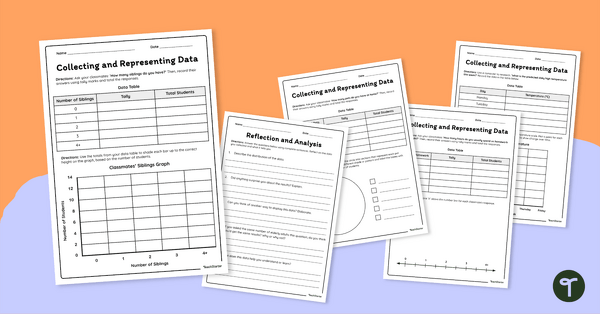
Collecting and Representing Data Worksheet Set
Download our collecting and representing data worksheet set to get your students collecting, organising and displaying data.
- Plus Plan
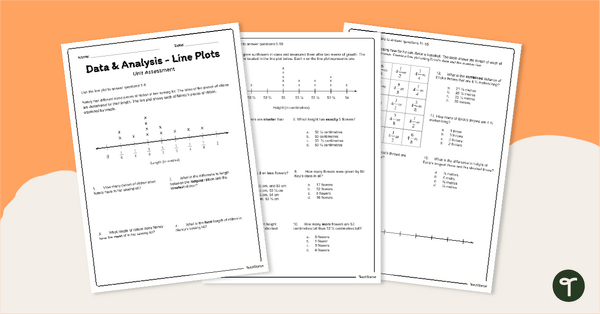
Line Plots / Dot Plots - Year 5 Assessment
Assess student understanding of reading and creating dot plots/line plots with a printable assessment for Year 5.
- Plus Plan
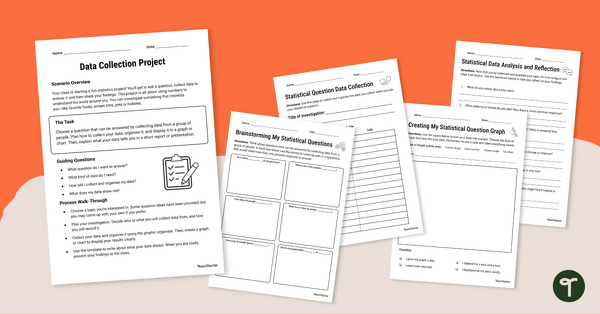
Data Collection Project
Complete this data collection project with your students to give them practise developing a statistical question, collecting data and displaying the results.
- Plus Plan
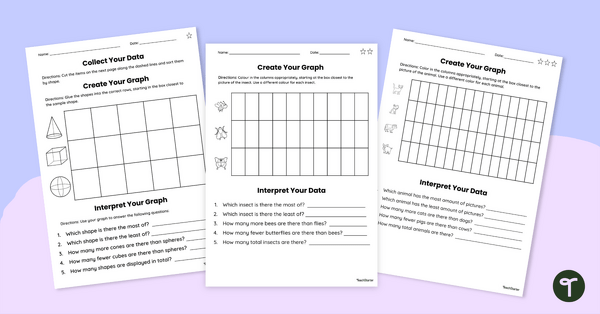
Data Collection Worksheet Set
Use this set of differentiated graphs worksheets to assess your students’ understanding of how data is collected, organised and presented.
- Plus Plan
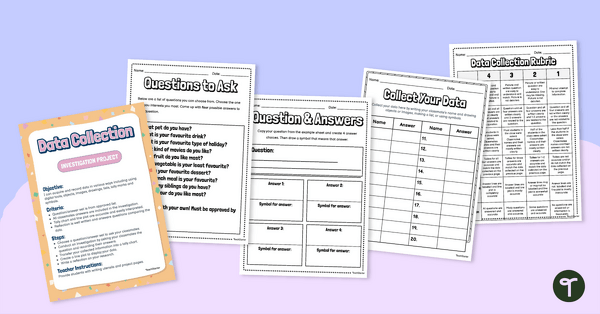
Data Collection Investigation Project
Assign this data collection project to enable students to master the skills of acquiring and recording data.
- Plus Plan
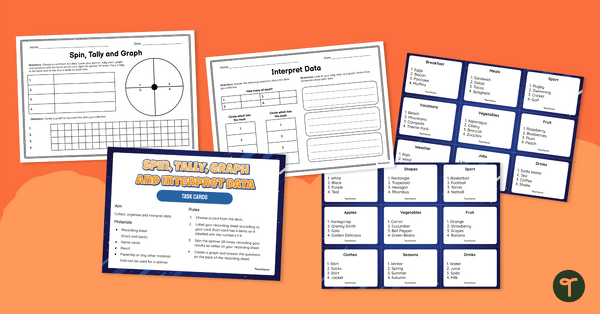
Spin, Tally, Graph and Interpret Data Task Card Activity
Guide your students to collect data, make tally marks, create a column graph and analyse data with this maths activity.
- Free Plan
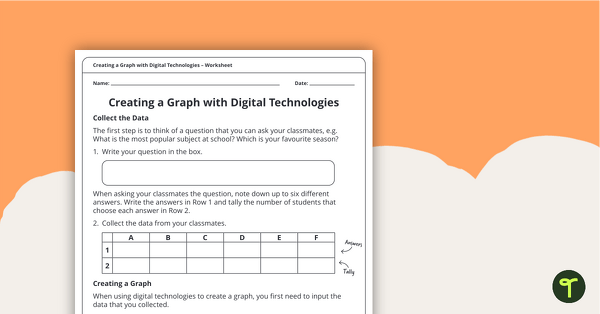
Creating a Graph Using Digital Technologies
A worksheet that supports students when collecting initial data and creating a digital graph.
- Plus Plan

Sports Day Dilemma - Metric Conversions Maths Task
Engage students with a real-world application of measurement conversions with Sports Day Dilemma, a metric conversion maths task!
- Plus Plan
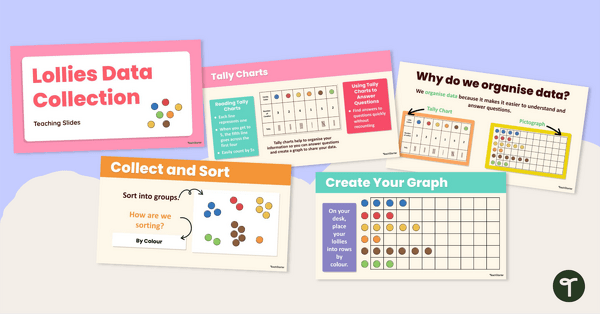
Lollies Data Collection Instructional Slide Deck
Explore this sweet-themed data collection teaching presentation to teach students the basics of recording data and creating a pictograph.
- Plus Plan
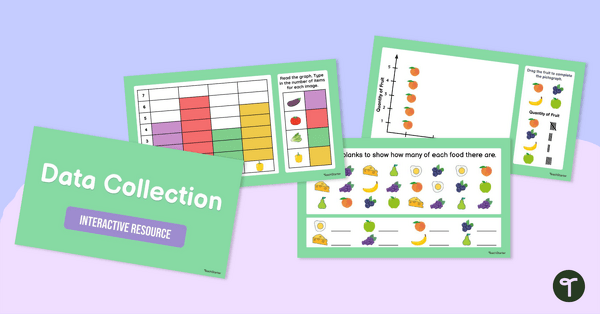
Data Collection Interactive Activity
Check your students’ understanding of interpreting data and using it to create graphs using this fun and colourful interactive game.